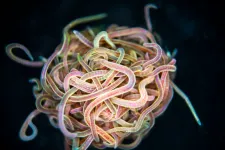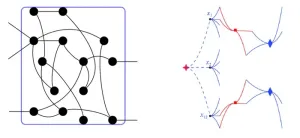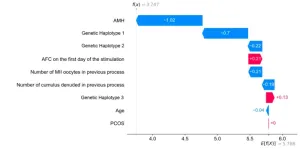Ever since scientists first read the complete genetic codes of creatures like fruit flies and humans more than two decades ago, the field of genomics has promised major leaps forward in understanding basic questions in biology.
And now comes a major installment of that promise. In what Howard Hughes Medical Institute Investigator and HHMI Professor Beth Shapiro calls a treasure trove of research, more than 150 researchers from 50 institutions are publishing 11 different papers in the April 28, 2023, issue of Science. The research brings new insights from the Zoonomia Project, an unprecedented collaborative effort led by Elinor Karlsson, director of the Vertebrate Genomics Group at the Broad Institute of MIT and Harvard, that compares and analyzes the complete genomes of 240 different mammalian species, from aardvarks to zebus.
The findings from this enormous amount of genetic data include pinpointing genes that underlie the ability to hibernate or how brains grew larger, as well as identifying the small fraction of genes that makes humans unique. “These 11 papers are just a sampling of the type of science that can be done with the new genetic data,” says Shapiro, professor of ecology and evolutionary biology at the University of California, Santa Cruz. “They show how important these large consortia and foundational datasets really are.”
Two of the papers, co-authored by Shapiro and her Santa Cruz team, break new ground by showing how much valuable information can be found in genomes of a single species, such as endangered orcas, or even in the DNA of an individual. That individual is a sled dog named Balto, who has been immortalized in movies and a statue for helping to bring lifesaving diphtheria antitoxin to Nome, Alaska in an epic journey across the Alaskan wilderness in the winter of 1925. With just a snippet of the dog’s preserved skin and “these amazing new techniques we didn’t have before, we were able to do this cool scientific thing,” says HHMI postdoc Katie Moon, lead author of the Balto paper and a member of Shapiro’s team.
Mass extinctions
One of Shapiro’s new papers tackles a high-stakes, urgent question in conservation. Humans are now causing mass extinctions and a serious loss of biodiversity across the planet. But which species are most at risk? Traditionally, conservationists tackled the question by painstakingly counting how many individuals are in a population and estimating how much habitat remains. Such efforts show that some species, like pumas in California, which Shapiro’s team has also worked on, are seriously endangered.
But what if the animal in question is one of many thousands of species for which no good population or habitat data exist? For those, Shapiro’s team wondered, might it be possible instead to estimate the threat of extinction simply by looking through the creatures’ genomes for “bad” genes or genetic evidence of inbreeding—the tell-tale signs of trouble?
To answer the question, co-lead authors, HHMI scientist Megan Supple and Aryn Wilder of the San Diego Zoo Wildlife Alliance, used the International Union for Conservation of Nature’s “Red List of Threatened Species” to rank the 240 mammals in the Zoonomia Project along a continuum from “least concern” to “critically endangered.” Then they looked for the worrisome signals in each animal’s genome.
The results show that the genomes are remarkably revealing. “Information encoded within even a single genome can provide a risk assessment in the absence of adequate ecological or population census data,” the paper reports. No good data exist on numbers or habitats for the Upper Galilee Mountains blind mole rat, a small tunnel-digging rodent, for example. But its genome shows the species is doing just fine, thanks. In contrast, both the genomic and ecological data for orcas confirm that killer whales are in serious danger.
The genomes’ predictive power can be harnessed in the effort to identify and save endangered species, Shapiro suggests. “We know we’ll never have enough conservation dollars to go around, but by using even one genome, we can triage species,” she explains—quickly and inexpensively identifying those creatures most at risk.
Champion sled dog racer
The stakes were lower for the second paper from Shapiro’s team, the sled dog effort, but it was a lot more fun, the researchers say. “I hope people enjoy reading about Balto as much as I enjoyed working on the project,” says Moon.
The origins of the project actually go back a few years. Heather Huson, a champion sled dog racer turned Cornell University animal geneticist, was giving a talk at a meeting of sled dog veterinarians when one of the vets in the audience wondered if it would be possible to extract and analyze DNA from preserved hide. He even had a potential study subject in mind—Balto, whose taxidermied body is displayed in a glass case at the Cleveland Museum of Natural History.
Huson was hooked on the idea. “I grew up on the stories about Balto,” she recalls. But she had no experience working with old DNA, “and I wasn’t going to screw this up,” she says. So she reached out to the ancient DNA research community. The path quickly led to Beth Shapiro, a pioneer in revealing the genetic secrets of extinct creatures like mastodons and of ancient humans in the field called paleogenomics. “I reached out to Beth, and she said, ‘We can do this,’” says Huson.
The researchers got a sample of Balto’s skin from the Cleveland Museum and extracted the dog’s DNA from the sample. Moonthen did the heavy genetic lifting in UC Santa Cruz’s high-tech ancient DNA lab, reading the code of Balto’s snippets of DNA enough times to cover his entire genome 40 times over.
Normally, scientists would learn about the genetics of a species in part by looking at genetic variations among different individuals. Balto was just one individual, though, so “the challenge was how to make a research project out of one dog,” says Huson. But the team had an ace up their sleeve. In addition to being able to compare the sled dog’s genome to the 240 mammals in the Zoonomia Project, they also could tap a genetic repository created by the Broad Institute’s Karlsson that has complete genomes of 682 dogs from a wide variety of breeds. “It’s an incredible dataset,” says Moon. Because of the information it contains “we know so much about dogs—what parts of the genome make them look the way they do or perform the way they do,” Moon explains. Or as Shapiro adds, the Balto project “was an opportunity to bring these two datasets together.”
Exciting moment
Using just the information in Balto’s genes, Kathleen Morrill, then a PhD student in Karlsson’s lab at the University of Massachusetts Chan Medical School, was able to predict both the dog’s precise height and the fact that his black coat had tan highlights at the edges—which don’t even show up in most pictures. A talented artist, Morrill was able to draw a rendering, based on the genetics, that was more accurate than many pictures. “Her drawing was what Balto would have looked like,” says Moon. “It was the first time anyone has done this on an individual that’s been gone for almost 100 years—and it was a really exciting moment for me.” It also validates the idea that scientists can use genomics to accurately envision what long-extinct species—for which no pictures exist—really looked like. “It shows we can do a pretty good job predicting their physical appearance,” says Huson.
There were plenty of other scientific nuggets in Balto’s DNA as well. Born in the kennel of famous sled dog breeder Leonard Seppala in 1919, Balto was descended from dogs imported from Siberia. “But one of the coolest things is how close Balto is to modern Alaskan sled dogs as well as to the Siberian husky,” says Huson. His genome shows a mix of ancestors, with fewer deleterious genes compared to modern purebred breeds like Siberian huskies and Alaskan Malamutes. His DNA is also rich in so-called tissue development genes, which are involved in functions like muscle growth, metabolism, and oxygen consumption. “That’s exactly what you would need in a working dog,” says Moon.
Yet the genetics also reveal Balto’s limitations. Sled dogs were originally bred for great endurance, but since Balto’s time, breeders added in more speed. “Balto might have been a tough sled dog with a lot of endurance, but he wouldn’t have been very fast,” says Huson.
In fact, sled dog experts know that Balto wasn’t actually the real hero of the lifesaving 1925 journey. That honor belongs to a dog named Togo, who led Seppala’s team on the longest leg of the 674 mile trek, an astonishing 264 miles (compared to Balto’s 53 miles on the final segment). “Balto was the 2nd string dog,” says Huson. Not being prime progenitor material, he was neutered, in contrast to Togo, “who is the dog—the foundation of a lot of sled dogs,” says Huson. So, the next step, she suggests, is getting a sample from Togo’s remains, now preserved in Nome, in order to reveal the next chapter in this canine genetic drama.
END




